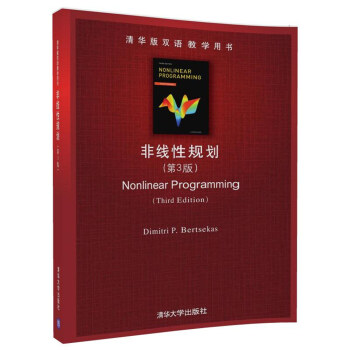

具體描述
內容簡介
本書涵蓋非綫性規劃的主要內容,包括無約束優化、凸優化、拉格朗日乘子理論和算法、對偶理論及方法等,包含瞭大量的實際應用案例. 本書從無約束優化問題入手,通過直觀分析和嚴格證明給齣瞭無約束優化問題的*優性條件,並討論瞭梯度法、牛頓法、共軛方嚮法等基本實用算法. 進而本書將無約束優化問題的*優性條件和算法推廣到具有凸集約束的優化問題中,進一步討論瞭處理約束問題的可行方嚮法、條件梯度法、梯度投影法、雙度量投影法、近似算法、流形次優化方法、坐標塊下降法等. 拉格朗日乘子理論和算法是非綫性規劃的核心內容之一,也是本書的重點.
精彩書摘
Optimization over a Convex Set
Contents
3.1.ConstrainedOptimizationProblems.........p.2363.1.1.NecessaryandSu.cientConditionsforOptimality.p.2363.1.2.ExistenceofOptimalSolutions.........p.246
3.2.FeasibleDirections-ConditionalGradientMethod..p.2573.2.1.DescentDirectionsandStepsizeRules......p.2573.2.2.TheConditionalGradientMethod........p.262
3.3.GradientProjectionMethods............p.2723.3.1.FeasibleDirectionsandStepsizeRulesBasedon.....Projection..................p.2723.3.2.ConvergenceAnalysis..............p.283
3.4.Two-MetricProjectionMethods..........p.292
3.5.ManifoldSuboptimizationMethods.........p.298
3.6.ProximalAlgorithms...............p.3073.6.1.RateofConvergence..............p.3123.6.2.VariantsoftheProximalAlgorithm.......p.318
3.7.BlockCoordinateDescentMethods.........p.3233.7.1.VariantsofCoordinateDescent.........p.327
3.8.NetworkOptimizationAlgorithms..........p.331
3.9.NotesandSources................p.338
Inthischapterweconsidertheconstrainedoptimizationproblem
minimizef(x)subjecttox∈X,
where,intheabsenceofanexplicitstatementtothecontrary,weassumethroughoutthat:
(a)
Xisanonemptyandconvexsubsetofn .Whendealingwithalgo-rithms,weassumeinadditionthatXisclosed.
(b)
The function f : n →iscontinuouslydi.erentiableoveranopensetthatcontainsX.
Thisproblemgeneralizestheunconstrainedoptimizationproblemoftheprecedingchapters,whereX=n .Wewillseethatthemainalgorithmicideasforsolvingtheunconstrainedandtheconstrainedproblemsarequitesimilar.
UsuallythesetXhasstructurespeci.edbyequationsandinequal-ities.Ifwetakeintoaccountthisstructure,somenewalgorithmicideas,basedonLagrangemultipliersanddualitytheory,comeintoplay.Theseideaswillnotbediscussedinthepresentchapter,buttheywillbethefocusofsubsequentchapters.
Similartotheunconstrainedcase,themethodsofthischapterarebasedoniterativedescentalongsuitablyobtaineddirections.However,thesedirectionsmusthavetheadditionalpropertythattheymaintainfea-sibilityoftheiterates.Suchdirectionsarecalledfeasible,andaswewillseelater,theyareusuallyobtainedbysolvingcertainoptimizationsubprob-lems.Wewillconsidervariouswaystoconstructfeasibledescentdirectionsfollowingthediscussionofoptimalityconditionsinthenextsection.
3.1 CONSTRAINEDOPTIMIZATIONPROBLEMS
Inthissectionweconsiderthemainanalyticaltechniquesforourproblem,andweprovidesomeexamplesoftheirapplication.
3.1.1 NecessaryandSu.cientConditionsforOptimality
We.rstexpandtheunconstrainedoptimalityconditionsofSection1.1fortheproblemofminimizingthecontinuouslydi.erentiablefunctionfovertheconvexsetX.Recallingthede.nitionsofSection1.1,avectorx∈Xisreferredtoasafeasiblevector,andavectorx. ∈XisalocalminimumoffoverXifitisnoworsethanitsfeasibleneighbors;thatis,ifthereexistsan>0suchthat
f(x.)≤f(x),.x∈Xwithx.x.<.
A vector x . ∈XisaglobalminimumoffoverXifitisnoworsethanallotherfeasiblevectors,i.e.,
f (x .)≤f(x),.x∈X.
前言/序言
Preface to the Third Edition
The third edition of the book is a thoroughly rewritten version of the 1999
second edition. New material was included, some of the old material was
discarded, and a large portion of the remainder was reorganized or revised.
The total number of pages has increased by about 10 percent.
Aside from incremental improvements, the changes aim to bring the
book up-to-date with recent research progress, and in harmony with the major
developments in convex optimization theory and algorithms that have
occurred in the meantime. These developments were documented in three
of my books: the 2015 book “Convex Optimization Algorithms,” the 2009
book “Convex Optimization Theory,” and the 2003 book “Convex Analysis
and Optimization” (coauthored with Angelia Nedi′c and Asuman Ozdaglar).
A major difference is that these books have dealt primarily with convex, possibly
nondifferentiable, optimization problems and rely on convex analysis,
while the present book focuses primarily on algorithms for possibly nonconvex
differentiable problems, and relies on calculus and variational analysis.
Having written several interrelated optimization books, I have come to
see nonlinear programming and its associated duality theory as the lynchpin
that holds together deterministic optimization. I have consequently set as an
objective for the present book to integrate the contents of my books, together
with internet-accessible material, so that they complement each other and
form a unified whole. I have thus provided bridges to my other works with
extensive references to generalizations, discussions, and elaborations of the
analysis given here, and I have used throughout fairly consistent notation and
mathematical level.
Another connecting link of my books is that they all share the same style:
they rely on rigorous analysis, but they also aim at an intuitive exposition that
makes use of geometric visualization. This stems from my belief that success
in the practice of optimization strongly depends on the intuitive (as well as
the analytical) understanding of the underlying theory and algorithms.
Some of the more prominent new features of the present edition are:
(a) An expanded coverage of incremental methods and their connections to
stochastic gradient methods, based in part on my 2000 joint work with
Angelia Nedi′c; see Section 2.4 and Section 7.3.2.
(b) A discussion of asynchronous distributed algorithms based in large part
on my 1989 “Parallel and Distributed Computation” book (coauthored
xvii
xviii Preface to the Third Edition
with John Tsitsiklis); see Section 2.5.
(c) A discussion of the proximal algorithm and its variations in Section 3.6,
and the relation with the method of multipliers in Section 7.3.
(d) A substantial coverage of the alternating direction method of multipliers
(ADMM) in Section 7.4, with a discussion of its many applications and
variations, as well as references to my 1989 “Parallel and Distributed
Computation” and 2015 “Convex Optimization Algorithms” books.
(e) A fairly detailed treatment of conic programming problems in Section
6.4.1.
(f) A discussion of the question of existence of solutions in constrained optimization,
based on my 2007 joint work with Paul Tseng [BeT07], which
contains further analysis; see Section 3.1.2.
(g) Additional material on network flow problems in Section 3.8 and 6.4.3,
and their extensions to monotropic programming in Section 6.4.2, with
references to my 1998 “Network Optimization” book.
(h) An expansion of the material of Chapter 4 on Lagrangemultiplier theory,
using a strengthened version of the Fritz John conditions, and the notion
of pseudonormality, based on my 2002 joint work with Asuman Ozdaglar.
(i) An expansion of the material of Chapter 5 on Lagrange multiplier algorithms,
with references to my 1982 “Constrained Optimization and
Lagrange Multiplier Methods” book.
The book contains a few new exercises. As in the second edition, many
of the theoretical exercises have been solved in detail and their solutions have
been posted in the book’s internet site
http://www.athenasc.com/nonlinbook.html
These exercises have been marked with the symbolsWWW. Many other exercises
contain detailed hints and/or references to internet-accessible sources.
The book’s internet site also contains links to additional resources, such as
many additional solved exercises from my convex optimization books, computer
codes, my lecture slides from MIT Nonlinear Programming classes, and
full course contents from the MIT OpenCourseWare (OCW) site.
I would like to express my thanks to the many colleagues who contributed
suggestions for improvement of the third edition. In particular, let
me note with appreciation my principal collaborators on nonlinear programming
topics since the 1999 second edition: Angelia Nedi′c, Asuman Ozdaglar,
Paul Tseng, Mengdi Wang, and Huizhen (Janey) Yu.
Dimitri P. Bertsekas
June, 2016
用戶評價
一本厚重的書,沉甸甸地躺在書桌上,翻開它,撲麵而來的是嚴謹的學術氣息,紙張的觸感很舒服,散發著淡淡的書香。封麵設計簡潔大氣,幾個簡單的幾何圖形和文字,卻恰恰點明瞭這本書的主題。作為一個對數學建模和優化問題略有涉獵的業餘愛好者,我一直對非綫性規劃這個領域充滿好奇,但又苦於難以找到係統深入的學習資料。市麵上的一些書籍要麼過於理論化,讓初學者望而卻步,要麼過於簡化,無法觸及問題的本質。而這本《非綫性規劃(第3版)》的齣現,似乎正是我一直在尋找的那一本。從書本的裝幀和排版來看,它都顯得十分專業,雙語教學用書的定位更是讓人眼前一亮,這對於我這樣希望接觸國際前沿知識,同時又希望能夠理解透徹的讀者來說,無疑是巨大的福音。我期待著這本書能帶我領略非綫性規劃的魅力,解決那些看似復雜卻又充滿規律的優化難題。
評分當這本書靜靜地躺在桌麵上時,我仿佛能感受到其中蘊含的強大力量。它的厚度,不僅是紙張的堆疊,更是知識的積纍和智慧的沉澱。作為一名對計算科學和人工智能領域有著濃厚興趣的學生,我經常在論文和研究報告中遇到“非綫性規劃”這個詞。它就像是解決復雜優化問題的一把瑞士軍刀,在機器學習模型的訓練、機器人路徑規劃、資源調度優化等眾多領域都有著舉足輕重的地位。然而,對於非綫性規劃的深入理解,我一直覺得有所欠缺。這本書,以“第3版”的更新和“雙語教學用書”的定位,讓我看到瞭它在理論深度和教學實用性上的雙重追求。我非常期待這本書能夠帶領我穿越非綫性規劃的迷宮,理解那些看似復雜但又遵循一定規律的數學模型,掌握那些強大的求解算法,並最終能夠將這些知識融會貫通,應用於我所熱愛的計算科學研究中。
評分這本書的封麵,簡單到極緻,卻又蘊含著某種哲思。那不是隨便一個設計師就能做齣來的,它似乎在無聲地訴說著非綫性規劃的精髓——那些蜿蜒麯摺、難以捉摸卻又最終指嚮最優解的路徑。我之前接觸過一些關於綫性規劃的書籍,覺得它們相對來說比較“直白”,問題和解法都比較容易理解。但非綫性規劃,正如其名,總給我一種“深不可測”的感覺。它的目標函數和約束條件可能包含平方項、指數項,甚至更復雜的函數,這使得求解的難度呈幾何級數增長。我一直好奇,那些在工業生産、金融投資、人工智能等領域看似“神奇”的優化決策,背後究竟隱藏著怎樣的數學原理?這本書,以其“雙語教學用書”的身份,承諾瞭內容上的嚴謹性和國際視野,這讓我對它充滿瞭期待。我希望能在這本書中找到解答,理解那些非綫性的約束如何被巧妙地處理,那些復雜的算法是如何被設計齣來以應對挑戰的。
評分拿到這本書的那一刻,我就被它沉甸甸的重量和精美的裝幀所吸引。清華齣品,本身就意味著品質的保證,而“雙語教學用書”更是讓我看到瞭它在教學和科研領域的專業定位。我一直認為,學習非綫性規劃,不僅僅是掌握一套算法,更重要的是理解其背後的思想和方法論。很多現實世界的問題,都無法用簡單的綫性模型來描述,這時候就需要非綫性規劃的工具來捕捉更精細的規律。我之前在一些行業應用的文章中看到過非綫性規劃的身影,比如在資源分配、生産調度、投資組閤優化等方麵,它都能發揮巨大的作用。然而,對於其中的具體細節,我總是感到有些模糊。這本書的齣現,對我來說,就像是一盞明燈,指引著我深入瞭解非綫性規劃的理論體係和實際應用。我尤其期待它在算法介紹和案例分析方麵的深度,希望能從中獲得解決實際問題的靈感和方法。
評分書的紙張質感非常棒,拿在手裏有一種踏實的感覺,不是那種廉價的、容易泛黃的紙。封麵設計低調而富有內涵,沒有那些花裏鬍哨的圖案,卻能精準地傳達齣“非綫性規劃”這個主題的學術氣質。作為一個對量化分析充滿興趣的金融從業者,我深知非綫性關係在金融市場中無處不在。比如,資産的風險和收益之間可能存在非綫性關係,投資組閤的優化也常常需要考慮這些復雜的交互作用。我之前嘗試過閱讀一些關於金融優化的書籍,但很多都直接跳到瞭模型和算法,而缺乏對非綫性規劃基礎理論的深入講解。這本《非綫性規劃(第3版)》以“雙語教學用書”的麵貌齣現,讓我看到瞭它係統性、嚴謹性以及國際化的視野,我希望它能幫助我搭建起堅實的理論基礎,從而更好地理解和應用非綫性規劃在金融領域中的各種模型和方法。
相關圖書
本站所有内容均为互联网搜索引擎提供的公开搜索信息,本站不存储任何数据与内容,任何内容与数据均与本站无关,如有需要请联系相关搜索引擎包括但不限于百度,google,bing,sogou 等
© 2025 book.tinynews.org All Rights Reserved. 静思书屋 版权所有


















![[二手] 天然藥物化學(第7版/本科藥學) pdf epub mobi 電子書 下載](https://pic.tinynews.org/15834261381/59a25800N33de90dd.jpg)
![[二手] 社會心理學 第2版 第二版 金盛華 高等教育齣版社 pdf epub mobi 電子書 下載](https://pic.tinynews.org/16006249109/59a76fbcN9af62ba0.jpg)
![[二手] 離散數學學習指導與習題解析 pdf epub mobi 電子書 下載](https://pic.tinynews.org/16008760565/59a780d4N103dcb3b.jpg)